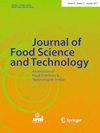葡萄酒酚类物质:寻找光滑的口感
IF 3.3
3区 农林科学
Q2 FOOD SCIENCE & TECHNOLOGY
引用次数: 6
摘要
每个葡萄品种都有自己的酚类成分。然而,葡萄酒中酚类化合物的浓度主要取决于酿酒工艺。酚类化合物影响葡萄酒的感官特征,即口感、苦味、涩味和颜色。人类可以感知六种基本的味道:甜、咸;酸的;鲜味;肥味和苦味。最后一种基本味道被认为是一种防御机制,防止摄入潜在的毒素。一些编码g蛋白偶联受体TAS2Rs的基因已经被确定,这些基因可以翻译成这些不同的苦味化合物探测器。不同的酚类化合物激活不同的TAS2Rs组合。葡萄酒中的涩味主要是由原花青素驱动的,可溶性蛋白质-原花青素复合物减少了保护性唾液膜并与唾液膜结合;不溶性蛋白-原花青素复合物和原花青素被唾液腺膜排斥,并通过增加摩擦引起涩味。因此,本综述的目的是扩大对葡萄酒酚类化合物在葡萄酒感官特性中的作用的认识,即在苦味和涩味现象中。本文章由计算机程序翻译,如有差异,请以英文原文为准。
Wine phenolics: looking for a smooth mouthfeel
Each grape variety has its own phenolic profile. However, the concentration of the phenolic compounds present in wine mainly dependson winemaking processes. Phenolic compounds influence wine sensorial characteristics namely taste or mouthfeel, bitterness, astringency and color. Humans can perceive six basic tastes: sweet, salty; sour; umami; fat-taste and bitter taste. This last basic taste is considered as a defense mechanism against the ingestion of potential poisons. Some of the genes,encoding G-protein-coupled receptors TAS2Rs, which translate for these distinct bitter compounds detectors have been identified. Different phenolic compounds activate distinguished combination of TAS2Rs.Astringency in wine is primarily driven by proanthocyanidins, soluble protein-proanthocyanidins complexes which diminish the protective salivary film and bind to the salivary pellicle; insoluble protein-proanthocyanidins complex and proanthocyanidins are rejected against salivary film and trigger astringency sensation via increasing friction. Thus, the aim of this review is to expand the knowledge about the role of wine phenolic compounds in wine sensorial properties, namely in bitterness and astringency phenomenon’s.
求助全文
通过发布文献求助,成功后即可免费获取论文全文。
去求助
来源期刊
CiteScore
7.70
自引率
0.00%
发文量
274
审稿时长
11 months
期刊介绍:
The Journal of Food Science and Technology (JFST) is the official publication of the Association of Food Scientists and Technologists of India (AFSTI). This monthly publishes peer-reviewed research papers and reviews in all branches of science, technology, packaging and engineering of foods and food products. Special emphasis is given to fundamental and applied research findings that have potential for enhancing product quality, extend shelf life of fresh and processed food products and improve process efficiency. Critical reviews on new perspectives in food handling and processing, innovative and emerging technologies and trends and future research in food products and food industry byproducts are also welcome. The journal also publishes book reviews relevant to all aspects of food science, technology and engineering.

 求助内容:
求助内容: 应助结果提醒方式:
应助结果提醒方式:


